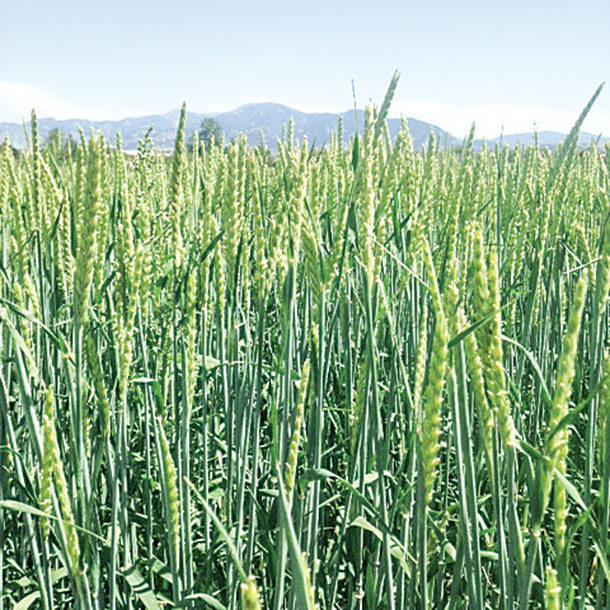Cover crops are generally water efficient, help reduce soil erosion, produce high-quality and high-yielding forages, and may have special value after multiple cropping cycles for soil improvement. Cover crops are also known as scavengers, converting nitrogen (N) to usable protein.
Cocktails can be created to meet grower demands – for instance, grass and brassicas can help to recycle excess N while legumes can be used to add more N back to the soil. However, in areas of the West with short growing seasons, choosing a cover crop that will meet grower demands can be difficult.
In many areas, use of certain crops is restricted due to a short growing season. This can be due to high elevations, a limited number of growing degree days or a combination of both. In Montana, we have found, and are still working on evaluating, several species that would be suitable for different climates throughout the region.
Cool-season cereals
Cool-season species are very popular in our region, as they can generally be planted from mid-March to mid-May or even in August through September to provide a fall grazing. Winter annuals are also commonly used in many cropping systems and can help to reduce the amount of time a field is in fallow.
However, care must be taken in order to decrease the potential of creating a “green bridge” for pests and diseases of cereal crops. Examples of cool-season species that are commonly used are oats, spring and winter wheat, triticale and barley.
- Cool-season cereals are readily available for grazing or termination in a fairly short period of time after planting compared to perennial forage species. Depending on your environment, species can be available for grazing, haying or termination six to nine weeks after planting.
- Great nutrient source to be added back to the soil via mulching or green manuring, or can also be used for hay or grazing
- Extensive fibrous root system increasing nutrient scavenging and recycling
- Caution should be used, as some have the potential for nitrate toxicity when stressed, especially oat.
- Wheat, barley and triticale also are at risk; however, they are usually at a lower risk than oats.
- Forage types are usually lower-risk than grain types.
- Always test prior to feeding if concerned about levels.
Warm-season cereals
Warm-season species have been evaluated in many areas and have been successful in areas that have enough growing degree units, particularly in the warm summer months. However, in some areas, warm-season species are not ideal and will not produce enough forage to be economical.

They are generally not frost-tolerant, and care must be taken when planting as there may be issues with producing enough vegetation. Species commonly used include sorghum, sudangrass, sorghum x sudan hybrids and different species of millet.
- Warm-season species should be planted when the top 1 inch of soil is at least 60ºF, typically sometime between late April through mid-August, depending on location.
- If planted too early, growth may be slow, leading to reduced population and increased chance of weed invasion.
- Mixtures of warm- and cool-season species are best suited for a later-season planting but, depending on the date, may favor one type or the other.
- Mixtures are being evaluated for their use in short-season climates such as Montana to determine mixture suitability.
- Warm-season cereals have the potential for both nitrate toxicity and prussic acid poisoning when stressed.
- Sorghum species are typically at the highest risk, followed by sorghum x sudan hybrids, then sudangrasses and millets.
- Care should always be taken before feeding any stressed forages to ensure levels are below toxic thresholds for livestock.
Cool-season brassicas
Brassicas are generally adapted to cool, sub-humid regions. In Montana, with rain or irrigation, they have very rapid growth in the fall as well as enhanced ability to scavenge nutrients and quickly produce a large amount of biomass.

Additionally, there has been some interest in brassica species, as it appears they can play a critical role in pest management and quickly cover the soil with their early “cabbage-like” growth habit. Examples of common brassica species include: canola, collard greens, kale, oilseed radish, mustard and turnip.
- Brassicas have a taproot that can be used to help increase soil porosity and retrieve deeper soil nutrients back to the surface for subsequent crops.
- Studies in Montana have found that some species, such as oilseed radish, need to be planted after June 15 to prevent bolting and grow an enlarged storage root that creates large soil cavities.
- If planted too early, the radish will bolt, leading to production of a normal taproot.
Annual legumes
Annual legumes, or pulse crops, have become extremely popular in this semiarid region, with over 1 million acres of field pea and lentil planted in Montana in 2016. Annual legumes have many benefits, including their ability to fix N, which can add N credits back to the soil, reducing the cost of N fertilizer for subsequent cereal crops as well as increasing forage quality for grazing animals or when hayed due to increased protein and energy content.
However, just like perennial legumes, annual legumes need to be properly inoculated at planting for adequate N fixation. Examples of annual legumes that have been grown in Montana include chickpea, fababean, fenugreek, field pea, grasspea and lentil.
- Fababean may be the annual legume with the greatest N fixation potential and high quality, but it is drought-sensitive and so has been grown on limited acreage in Montana as a seed crop under dryland conditions.
- Fenugreek seed is the shape and color of alfalfa seed but is about three times as large, simplifying seeding. Fenugreek hay is popular in the equine community but is reported to have near-addictive properties.
- Field pea has been the most-studied annual forage in Montana next to cereal forages. A forage type is used when grazing or haying is the goal, with similar or greater quality than alfalfa.
- Harvesting can be an economic optimization challenge when considering optimal time for harvest.
- N fixation usually ceases by first bloom under early drought stress, while soil water use increases past first bloom and biomass may double during the three-week post-bloom period.
- Depending on seed price, lentil may be cheaper to seed than pea, but its N fixation and forage production have been consistently less than pea.
- Grasspea (or “chickling vetch”) has been shown to fix N comparably with field pea and is well adapted to the semiarid Northern Plains.
- The seed does contain neurotoxins which can cause a debilitating disease in humans (lathyrism) if consumed in sufficient quantities over time; its effect on ruminants is less well-known but not known to be a concern and thought to be safe for livestock consumption, but caution should still be used.
- Chickpea, while considered nutrient-dense, is generally far too expensive due to seed costs to justify using as a cover or forage crop.
In summary, cover crops are an important crop that can be effectively incorporated into many crop rotations. Cover crops can help improve soil conditions while providing other benefits such as a forage source and even fertilizer inputs.
Cocktails can help to provide many benefits by using species from different groups and the benefits each can provide. Contact your local extension agent, extension specialist, NRCS agent or crop adviser for more information on cover crops that can fit your specific needs and environment. ![]()
PHOTO 1: Cool-season cereal: Barley planted in Bozeman, Montana.
PHOTO 2: Cool-season cereal: Oats planted in Bozeman, Montana.
PHOTO 3: Cool-season brassica: Irrigated turnips planted near Townsend, Montana, last year.
PHOTO 4: Warm-season cereal: Sorghum-sudangrass hybrid in the vegetative stage. Field was planted in the middle of June in Bozeman, Montana, under wheel-line irrigation. This picture was taken on July 18, 2016. Photos courtesy of Emily Glunk and Susan Tallman.
Perry Miller, Ph.D., is with Montana State University. Susan Tallman, CCA, is with USDA-NRCS in Bozeman, Montana.

-
Emily Glunk
- Extension Forage Specialist
- Montana State University
- Email Emily Glunk










